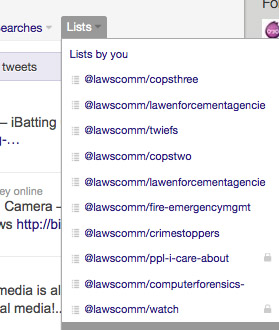Welcome to the the next installment in my series of social media tips. These are aimed primarily at a police audience, but hopefully applicable to a wider group of people too, especially those in the public sector. This series of posts will aim to identify some good practice and useful hints and tips for police officers and staff to consider when using social media.
Part 10: Operational Use
 One of the more common themes around police use of social media is the question of how it can be used operationally. There is often a lot of scepticism – it is fine for ‘engagement’ but not for so called ‘real policing’. A number of forward thinking forces and individuals have however made a great deal of progress using social media in the more operational areas of policing.
One of the more common themes around police use of social media is the question of how it can be used operationally. There is often a lot of scepticism – it is fine for ‘engagement’ but not for so called ‘real policing’. A number of forward thinking forces and individuals have however made a great deal of progress using social media in the more operational areas of policing.
I have already blogged about how better engagement leads to operational outcomes, so won’t repeat that here. This post is all about using social media in public order.
Public Order
Policing of public order is changing rapidly. Demonstrators have become aware of the power of organising marches and protests over the internet, and the rise of mobile social media such as Twitter on smartphones has meant that protests can be organised almost spontaneously, and without a clear leadership or organising group. This obviously causes difficulties for policing – in the UK forces are used to negotiating with groups about marches and protests, agreeing routes and locations, and using information on routes, numbers etc to plan for the degree of policing required in advance.
Social media has also been used by protestors to push false information in order to stir up trouble. Tweets from the English Defence League (a far right group) have included ones alleging that their supporters have been attacked by Muslims, and asking for people to come and support their protest.
Effective use of social media by police:
- Monitors the arrangements for a protest in advance. Most marches are organised via a Facebook page, and / or using a Twitter hashtag (a name preceded by a #). These are open and public, and can be an excellent source of intelligence.
- Engages with the organisers in advance. Again the open nature of Facebook and Twitter means that the police can talk to people who are interested in the protest, and explain why certain actions and routes may not be possible, and the actions that police will take. Early engagement is probably the area where most can be gained. As with all social media engagement it needs to be a two way conversation, however.
- Promotes messages via the hashtag and facebook page on the day of the protest. These can be about the route, police tactics, safety messages, and engaging with protestors in a positive way where they are within the law. Where arrests or other tactics are needed, then police forces should explain what has happened and why, to crush rumours. Which brings me to…
- puts the record straight. In the above example of protesters being attacked by Muslims, the police response was straightforward – there have been no attacks, and no one is injured.
- creates a reason to be followed. As with all social media, simply regurgitating press releases is dull – a good police presence informs, communicates, discusses and (where appropriate) amuses. Provide an insight into policing of protest, and people will follow you. Don’t be afraid to ask people to follow you either – if you use the hashtag and are providing good information, then people will.
A few things to remember
- Use the hashtag – people will be following or searching for this, and will automtaically pick up police tweets that use it, whether they follow you or not.
- Anything you can do they can do better – modern technology is cheap and ubiquitous, and the public are not limited by procurement and ICT department rules. Assume that everything you do is being videoed, edited and uploaded to the internet as you do it, and you will probably be correct.
Photo: Crowd – Image via Flick’r by DavidMartynHunt
This post was previously published on Partrdigej’s blog.
Related posts:
Using Twitter Hashtags for Emergency Management by Scott Mills
Seizing the Virtual Scene by Lauri Stevens
West Midlands (UK) Police: Twitter on the Frontline by Mark Payne
Previous posts from the Social Media Handbook Series:
Part 1: What Social Media networks should I use?
Part 2: How do I get followers / friends ???
Part 3: Policies / Strategies / Guidance??
Part 4: Ten things to have on your page to drive up interest??
Part 5: What to do when things go wrong
Part 6: We don’t do that here
Part 7: Basic Guides – Twitter and Flick’r
Part 8: Connect it all together
Part 9: Talk to local people

Justin Partridge
Justin Partridge is a senior manager for Lincolnshire Police in England. He also works on Local Policing and Partnerships for the Association of Chief Police Officers (ACPO).
Justin Partridge has worked in the public sector since leaving university, and for the police since 2003. After being one of only three non-sworn staff selected for the prestigious Police Strategic Command Course (for those who aspire to the most senior posts in UK policing), he started working on the national Local Policing and Partnerships area with chief officers from across the UK, and with partners from the Home Office, NPIA, APA and elsewhere.
Justin is passionate about making a difference to people, and see social media and new technologies having a major role in this – especially in policing and the wider public sector. He blogs on a variety of issues, predominantly around police and technology, and can be found on Twitter talking about much the same.










